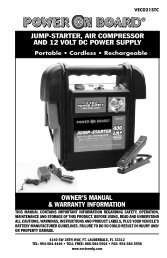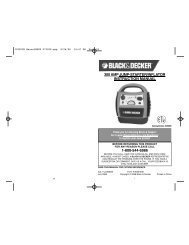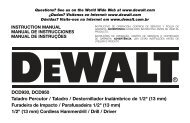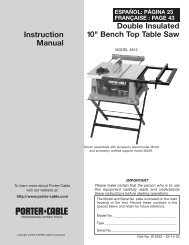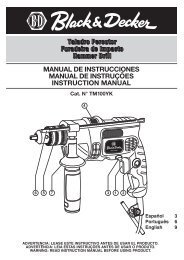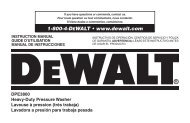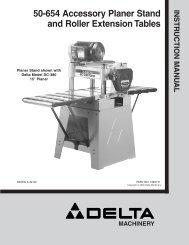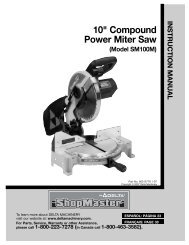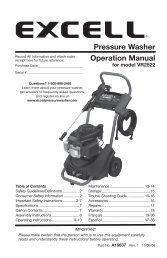INSTRUCTION MANUAL - Black & Decker
INSTRUCTION MANUAL - Black & Decker
INSTRUCTION MANUAL - Black & Decker
Create successful ePaper yourself
Turn your PDF publications into a flip-book with our unique Google optimized e-Paper software.
PERATING <strong>INSTRUCTION</strong>S<br />
MOVING AND INSTALLING BITS<br />
o install a bit simply insert it into the cavity in the spindle. To remove the bit pull straight out.<br />
MOVING AND INSTALLING THE BATTERY<br />
NOTE: VERSAPAK BATTERIES ARE NOT FULLY CHARGED AT THE FACTORY.<br />
o install the battery into the tool, slide it into the handle until it clicks into place.<br />
o remove the VersaPak battery from the tool, press the release button, (Fig. 3), and pull the battery out of the<br />
ool.<br />
NOTE: Battery caps are provided for use when carrying batteries or while battery is stored in a pocket, tool<br />
box, etc. Remove cap before placing battery in charger or tool.<br />
nstall the battery cap, (Fig. 2), by snapping it in place. To remove the cap, simply pull it off.<br />
WITCH<br />
VP720, VP730) To turn the tool ON in a forward direction, slide the switch button to the right. DEPRESS the<br />
SWITCH button and the tool will run. To operate in reverse, slide the switch button to the left. DEPRESS the<br />
SWITCH button and the tool will run. With the switch button in any position and NOT depressed, the tool will<br />
ock and act as any conventional, non-powered screwdriver.<br />
VP750, VP760) To turn the tool ON in a forward direction, press the top section of the rocker switch and the<br />
ool will run. To operate in reverse, press the bottom section of the rocker switch and the tool will run. Without<br />
depressing the rocker switch the tool is locked and will act as any conventional, non-powered screwdriver.<br />
ORQUE CONTROL (VP730, VP760 Only)<br />
Your screwdriver is equipped with an adjustable clutch control feature. When the tool reaches the preselected<br />
orque setting the clutch slips, thus limiting how tightly a screw is driven.<br />
NOTE: The tool’s motor will continue to run as long as the switch button is depressed.<br />
o set the tool’s torque, rotate the adjustable clutch collar (Fig. 3) clockwise or counterclockwise as required.<br />
he higher the number, the higher the torque. Each click in a clockwise direction (facing the spindle) means an<br />
ncrease in the torque produced.<br />
WO POSITION SCREWDRIVER (VP750, VP760 Only)<br />
o convert the tool to an angled screwdriver pull back on the release button shown in Fig. 4 and rotate the top<br />
portion of the tool as shown in Figures 5 and 6.<br />
TWO POSITION SCREWDRIVER WARNINGS:<br />
• To avoid being pinched, hold the screwdriver as shown in Figures 5 and 6 when changing positions.<br />
• Do not use screwdriver as a pry bar in either position.<br />
• To avoid screwdriver being turned on accidentally, do not carry in your pocket.<br />
AINTENANCE<br />
Use only mild soap and damp cloth to clean the tool. Never let any liquid get inside the tool; never immerse<br />
any part of the tool into a liquid.<br />
MPORTANT: To assure product SAFETY and RELIABILITY, repairs, maintenance and adjustment (other than<br />
hose listed in this manual) should be performed by authorized service centers or other qualified service<br />
organizations, always using identical replacement parts.<br />
HE RBRC SEAL<br />
he RBRC (Rechargeable Battery Recycling Corporation) Seal on the nickel-cadmium battery<br />
or battery pack) indicates that the costs to recycle the battery (or battery pack) at the end of its<br />
Ni-Cd<br />
useful life have already been paid by <strong>Black</strong> & <strong>Decker</strong>. In some areas, it is illegal to place spent<br />
nickel-cadmium batteries in the trash or municipal solid waste stream and the RBRC program provides an<br />
nvironmentally conscious alternative.<br />
RBRC in cooperation with <strong>Black</strong> & <strong>Decker</strong> and other battery users, has established programs in the United<br />
States and Canada to facilitate the collection of spent nickel-cadmium batteries. Help protect our environment<br />
and conserve natural resources by returning the spent nickel-cadmium battery to an authorized<br />
<strong>Black</strong> & <strong>Decker</strong> service center or to your local retailer for recycling. You may also contact your local recycling<br />
enter for information on where to drop off the spent battery, or call 1-800-8-BATTERY.<br />
CCESSORIES<br />
Recommended accessories for use with your tool are available from your local dealer or authorized service<br />
enter. If you need assistance regarding accessories, please call: 1-800-54-HOW-TO.<br />
WARNING: The use of any accessory not recommended for use with this tool could be hazardous.<br />
RVICE INFORMATION<br />
<strong>Black</strong> & <strong>Decker</strong> offers a full network of company-owned and authorized service locations throughout North<br />
America. All <strong>Black</strong> & <strong>Decker</strong> Service Centers are staffed with trained personnel to provide customers with<br />
fficient and reliable power tool service.<br />
Whether you need technical advice, repair, or genuine factory replacement parts, contact the <strong>Black</strong> & <strong>Decker</strong><br />
ocation nearest you. To find your local service location, refer to the yellow page directory under “Tools—<br />
Electric” or call: 1-800-54-HOW TO.<br />
ULL TWO-YEAR HOME USE WARRANTY<br />
<strong>Black</strong> & <strong>Decker</strong> (U.S.) Inc. warrants this product for two years against any defects in material or<br />
workmanship. The defective product will be replaced or repaired at no charge in either of two ways.<br />
he first, which will result in exchanges only, is to return the product to the retailer from whom it was<br />
purchased (provided that the store is a participating retailer). Returns should be made within the time period<br />
of the retailer’s policy for exchanges (usually 30 to 90 days after the sale). Proof of purchase may be<br />
equired. Please check with the retailer for their specific return policy regarding returns that are beyond the<br />
me set for exchanges.<br />
he second option is to take or send the product (prepaid) to a <strong>Black</strong> & <strong>Decker</strong> owned or authorized Service<br />
Center for repair or replacement at our option. Proof of purchase may be required. <strong>Black</strong> & <strong>Decker</strong> owned<br />
and authorized Service Centers are listed under “Tools-Electric” in the yellow pages of the phone directory.<br />
his warranty does not apply to accessories. This warranty gives you specific legal rights and you may have<br />
other rights which vary from state to state and province to province. Should you have any questions, contact<br />
he manager of your nearest <strong>Black</strong> & <strong>Decker</strong> Service Center. This product is not intended for commercial use.<br />
RBRC<br />
RBRC<br />
• Éloigner les curieux, les enfants et les visiteurs de la zone<br />
Une distraction peut entraîner la perte de maîtrise de l'outil<br />
MESURES DE SÉCURITÉ RELATIVES À L'ÉLECTRICITÉ<br />
• Les outils à double isolation comportent une fiche polarisé<br />
n'entre que d'une façon dans une prise polarisée. Lorsqu<br />
essayer de nouveau après avoir inversé les broches de la<br />
prise, communiquer avec un électricien certifié afin de fai<br />
aucune façon la fiche. La double isolation élimine le be<br />
système d'alimentation mis à la terre.<br />
• Éviter de toucher à des surfaces mises à la terre comme de<br />
réfrigérateurs. Les risques de secousses électriques sont plu<br />
terre.<br />
• Protéger les outils électriques de la pluie ou des conditions<br />
augmente les risques de secousses électriques.<br />
• Manipuler le cordon avec soin. Ne jamais se servir du co<br />
cordon pour débrancher l'outil. Éloigner le cordon des so<br />
tranchantes et des pièces mobiles. Remplacer immédiate<br />
endommagés augmentent les risques de secousses électriqu<br />
• Lorsqu'on utilise un outil électrique à l'extérieur, se servir<br />
portant la mention "W-A" ou "W". Ces cordons sont con<br />
risques de secousses électriques.<br />
SÉCURITÉ PERSONNELLE<br />
• Demeurer vigilant, prendre soin et faire preuve de jugeme<br />
s'en servir lorsqu'on est fatigué ou affaibli par des drogue<br />
blessures peuvent résulter d'un moment d'inattention lors de<br />
• Porter des vêtements appropriés. Éviter de porter des vêt<br />
chevelure si elle est longue. Éloigner les cheveux, les vête<br />
peuvent les happer.<br />
• Éviter les démarrages accidentels. S'assurer que l'interru<br />
brancher l'outil. Afin d'éviter les risques de blessures, ne p<br />
l'interrupteur ni brancher un outil dont l'interrupteur est en p<br />
• Enlever les clés de réglage avant de mettre l'outil sous ten<br />
de l'outil présente des risques de blessures.<br />
• Ne pas dépasser sa portée. Garder son équilibre en tout<br />
l'outil dans des situations imprévues grâce à une position st<br />
• Porter de l'équipement de sécurité. Toujours porter des lu<br />
faut porter des masques respiratoires, des chaussures antid<br />
tympans.<br />
UTILISATION ET ENTRETIEN DE L'OUTIL<br />
• Utiliser des pinces de serrage ou de tout autre moyen pra<br />
ouvrer sur une plate-forme stable. La pièce est instable lo<br />
l'utilisateur. Cela présente des risques de perte de maîtrise<br />
• Ne pas forcer l'outil. Utiliser l'outil approprié à la tâche.<br />
lorsqu'on s'en sert à son rendement nominal.<br />
• Ne pas se servir de l'outil lorsque l'interrupteur est défect<br />
faut le réparer.<br />
• Débrancher l'outil de la source d'alimentation avant de le<br />
ranger. On minimise de la sorte le risque de démarrage ac<br />
• Ranger l'outil hors de portée des enfants et de toute autre<br />
fonctionnement. L'outil est dangereux entre les mains de ce<br />
• Prendre soin des outils. S'assurer que les outils de coupe<br />
entretenus à arêtes tranchantes ont moins tendance à se co<br />
• Vérifier l'alignement et les attaches des pièces mobiles, le<br />
facteur susceptible de nuire au bon fonctionnement de l'o<br />
s'en servir. Des outils mal entretenus sont la cause de nomb<br />
• Utiliser seulement les accessoires recommandés par le fab<br />
peuvent présenter des risques avec un autre outil.<br />
ENTRETIEN<br />
• Confier l'entretien de l'outil seulement à du personnel qua<br />
présente des risques de blessures.<br />
• Lors de l'entretien de l'outil, utiliser seulement des pièces d<br />
relatives à l'entretien du présent guide d'utilisation. Il y a<br />
lorsqu'on utilise des pièces non autorisées ou lorsqu'on ne<br />
MESURES DE SÉCURITÉ ADDITIONNELLES<br />
• Saisir les surfaces isolées de l'outil lorsqu'on s'en sert là o<br />
lorsqu'il pourrait entrer en contact avec son propre fil. En<br />
composantes métalliques à découvert de l'outil deviendraie<br />
secousses électriques.<br />
L’étiquette de l’outil peut comporter les symboles suiva<br />
V ....................................volts<br />
Hz ..................................hertz<br />
min ................................minutes<br />
..............................courant continu<br />
..................................construction de classe II<br />
..................................symbole d´avertissement<br />
IMPORTANTES MESURES DE SéCURITé (p



